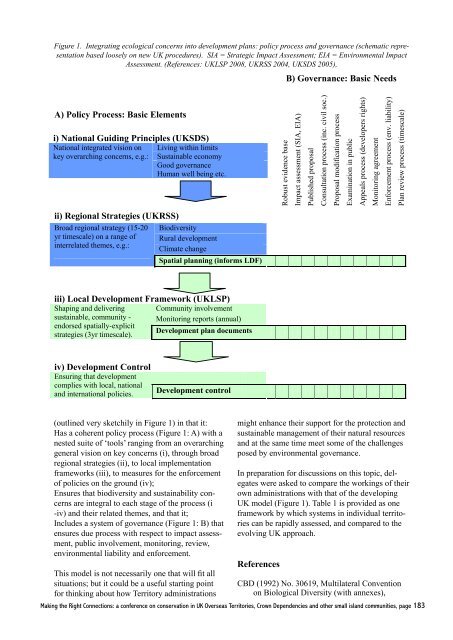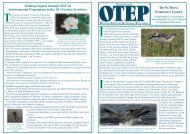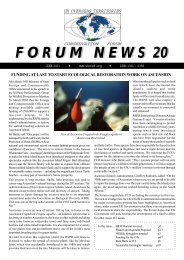Section 06 - UKOTCF
Section 06 - UKOTCF
Section 06 - UKOTCF
Create successful ePaper yourself
Turn your PDF publications into a flip-book with our unique Google optimized e-Paper software.
Figure 1. 1: Integrating Integrating ecological ecological concerns into concerns development into plans: development policy process plans: and governance policy process (schematic and representation<br />
based (schematic loosely on new representation UK procedures). based SIA = Strategic loosely Impact on new Assessment; UK procedures). EIA = Environmental Impact<br />
governance<br />
Assessment. (References: UKLSP 2008, UKRSS 2004, UKSDS 2005),<br />
B) Governance: Basic Needs<br />
A) Policy Process: Basic Elements<br />
i) National Guiding Principles (UKSDS)<br />
National integrated vision on Living within limits<br />
key overarching concerns, e.g.: Sustainable economy<br />
Good governance<br />
Human well being etc.<br />
ii) Regional Strategies (UKRSS)<br />
Broad regional strategy (15-20<br />
yr timescale) on a range of<br />
interrelated themes, e.g.:<br />
Biodiversity<br />
Rural development<br />
Climate change<br />
Spatial planning (informs LDF)<br />
Robust evidence base<br />
Impact assessment (SIA, EIA)<br />
Published proposal<br />
Consultation process (inc. civil soc.)<br />
Proposal modification process<br />
Examination in public<br />
Appeals process (developers rights)<br />
Monitoring agreement<br />
Enforcement process (env. liability)<br />
Plan review process (timescale)<br />
iii) Local Development Framework (UKLSP)<br />
Shaping and delivering Community involvement<br />
sustainable, community - Monitoring reports (annual)<br />
endorsed spatially-explicit<br />
Development plan documents<br />
strategies (3yr timescale).<br />
iv) Development Control<br />
Ensuring that development<br />
complies with local, national<br />
and international policies.<br />
Development control<br />
(outlined very sketchily in Figure 1) in that it:<br />
Has a coherent policy process (Figure 1: A) with a<br />
nested suite of ‘tools’ ranging from an overarching<br />
general vision on key concerns (i), through broad<br />
regional strategies (ii), to local implementation<br />
frameworks (iii), to measures for the enforcement<br />
of policies on the ground (iv);<br />
Ensures that biodiversity and sustainability concerns<br />
are integral to each stage of the process (i<br />
-iv) and their related themes, and that it;<br />
Includes a system of governance (Figure 1: B) that<br />
ensures due process with respect to impact assessment,<br />
public involvement, monitoring, review,<br />
environmental liability and enforcement.<br />
This model is not necessarily one that will fit all<br />
situations; but it could be a useful starting point<br />
for thinking about how Territory administrations<br />
might enhance their support for the protection and<br />
sustainable management of their natural resources<br />
and at the same time meet some of the challenges<br />
posed by environmental governance.<br />
In preparation for discussions on this topic, delegates<br />
were asked to compare the workings of their<br />
own administrations with that of the developing<br />
UK model (Figure 1). Table 1 is provided as one<br />
framework by which systems in individual territories<br />
can be rapidly assessed, and compared to the<br />
evolving UK approach.<br />
References<br />
CBD (1992) No. 3<strong>06</strong>19, Multilateral Convention<br />
on Biological Diversity (with annexes),<br />
Making the Right Connections: a conference on conservation in UK Overseas Territories, Crown Dependencies and other small island communities, page 183







